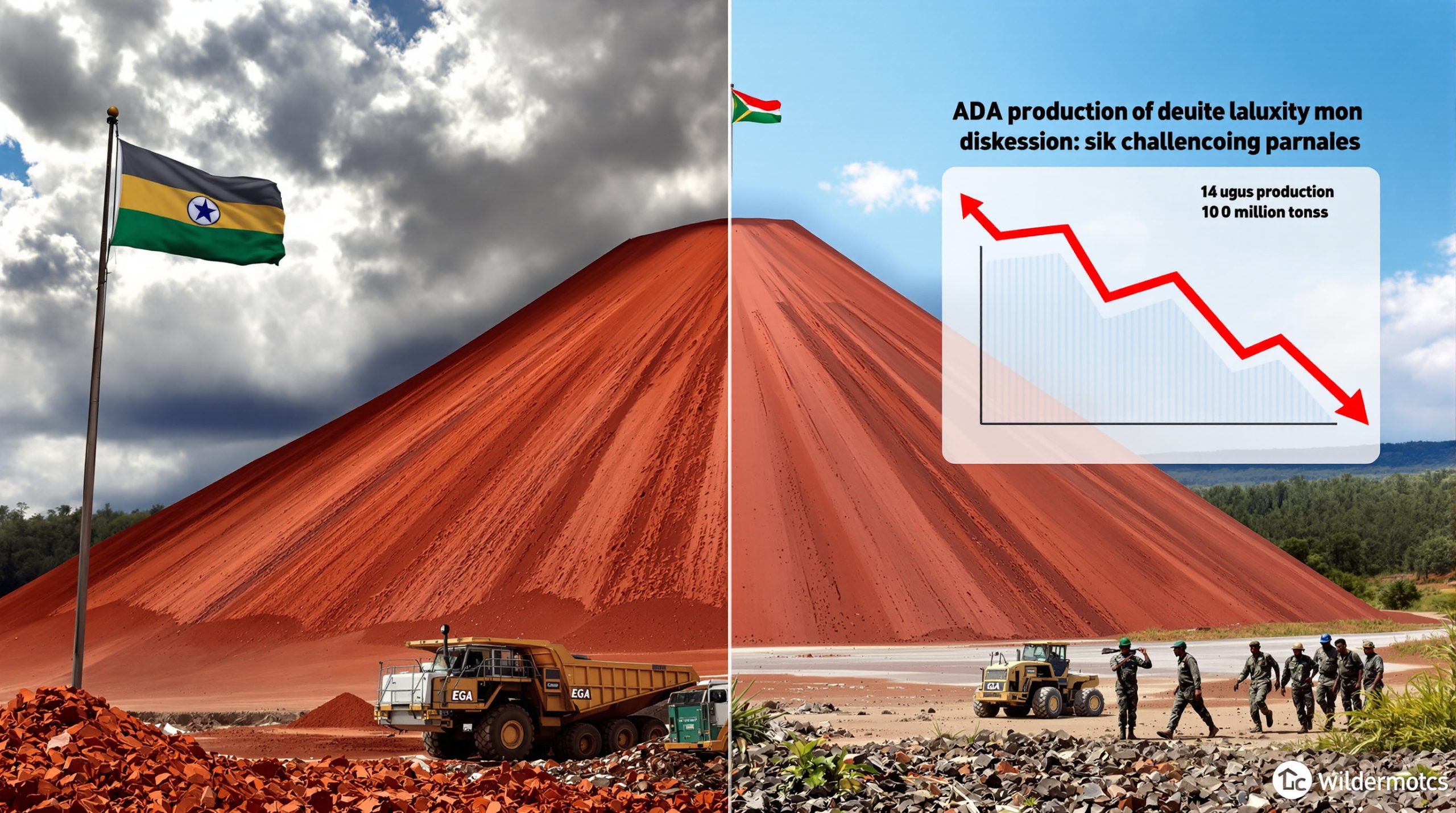Tamarack and America's Critical Minerals Strategy: Securing Domestic Nickel Supply
America's mineral independence faces a critical test with the Tamarack project in Minnesota. As one of the most promising nickel-copper-PGE deposits in the United States, it represents a crucial intersection of national security interests, environmental policy concerns, and the ongoing transition toward green energy. With current domestic nickel production at just 8,000 tonnes annually—less than 0.3% of global output—and the country's only operating nickel mine scheduled to close by 2029, Tamarack stands poised to become the cornerstone of America's domestic nickel importance & uses.
Why Is Tamarack Critical to America's Mineral Independence?
The United States currently faces a severe nickel deficit at a pivotal moment in its industrial development. Ranking a distant 9th globally in nickel production, the U.S. stands in stark contrast to market leaders like Indonesia (2.2 million tonnes), the Philippines (330,000 tonnes), and Russia (210,000 tonnes). This overwhelming dependence on foreign sources—many controlled by Chinese companies or geopolitical competitors—creates substantial vulnerability for American manufacturing and defense sectors.
America's Nickel Supply Challenge
The strategic implications of America's nickel shortage are profound. With domestic production covering less than 1% of U.S. consumption, the country relies heavily on imports for this critical mineral. This dependence creates vulnerability in several ways:
- Supply chain fragility: Geopolitical tensions can disrupt nickel supply chains
- Price volatility: Limited domestic production leaves U.S. manufacturers exposed to international market fluctuations
- National security concerns: Critical defense applications require secure nickel supplies
- Transition challenges: The shift to electric vehicles will dramatically increase nickel demand
"The nickel supply situation in America represents perhaps the most severe critical mineral vulnerability we face today. With Eagle Mine's closure approaching, Tamarack isn't just important—it's essential to maintaining any domestic production capacity." — Mining industry analyst
Strategic Importance Beyond Batteries
While nickel's role in EV batteries dominates current discussions, its strategic importance extends far beyond the green transition:
- Defense applications: Essential component in military aircraft, naval vessels, and armor
- High-performance steel: Required for infrastructure projects, aerospace, and transportation
- Industrial manufacturing: Critical for equipment used in chemical processing, petroleum refining, and food preparation
- Historical strategic asset: Russia's use of Norilsk nickel resources to fuel military capabilities demonstrates the mineral's strategic value
The critical nature of nickel to national security was underscored by its inclusion in the U.S. Geological Survey's list of 35 critical minerals strategy in 2022, highlighting the urgent need for domestic supply development.
What Makes Tamarack a Potential World-Class Discovery?
The geological setting of the Tamarack Intrusive Complex (TIC) suggests exceptional potential that extends well beyond current resource estimates. Recent drilling results have revealed characteristics comparable to globally significant nickel deposits, with indications that the project could contain substantially more mineralization than initially identified.
Geological Formation and Mineralization Model
The TIC represents what geologists consider an ideal environment for magmatic sulfide formation, featuring several key characteristics:
- Feeder conduit structure: Functions as a channel associated with continental rifting
- Magma dynamics: Facilitates emplacement of large volumes of mafic magma
- Ideal mixing conditions: Hot TIC magma provides metals while surrounding sedimentary rocks contribute necessary sulfur
- Fluid mechanics advantage: Conduit flow enables thorough mixing of ingredients into rich sulfide melt
- Density-driven concentration: Dense sulfide melt sinks, forming pools of high-grade mineralization in structural traps
This geological model closely resembles that of world-class deposits like Norilsk (Russia) and Voisey's Bay (Canada), suggesting Tamarack's potential significance may be substantially underestimated by current resource calculations.
Evidence of Exceptional Potential
Recent drilling results have revealed what geologists term a "waterfall pattern" of mineralization, where sulfides flow down geological structures to form deep pools of high-grade material. Cross-sectional analysis reveals gently dipping ore bodies that suddenly plunge downward, with significantly higher grades and longer intercepts near the bottom—considered a highly promising indicator of substantial mineralization at depth.
The geological evidence suggests Tamarack may represent only the upper portion of a much larger mineralized system, with the most valuable concentrations potentially lying deeper than current drilling has reached. This pattern mirrors the structure of several world-class magmatic sulfide deposits that started with modest initial resource estimates before expanding dramatically through deeper exploration.
Remarkable Exploration Success Rate
Talon's drilling program has achieved extraordinary success rates that suggest either substantial mineralization or exceptional targeting capability:
- 27 out of 33 holes (82%) within the resource area hit massive sulfides
- 4 out of 5 holes (80%) outside the resource area intercepted mineralization
- Approximately 50% of holes in the Raptor Zone hit significant mineralization
- First hole at their Michigan Boulderdash project intercepted 99.92 meters grading 1.6% copper equivalent
These success rates far exceed industry norms for magmatic sulfide exploration, which typically sees hit rates below 20% even in established deposits. Such consistent interception of mineralization strongly suggests both extensive deposit size and unusually effective targeting technology.
How Does Talon's Exploration Approach Differ?
Talon Metals has implemented an unconventional but highly effective exploration strategy that sets it apart from most junior mining companies, potentially explaining their unusual success in delineating the Tamarack deposit.
Integrated In-House Capabilities
Unlike most exploration companies that outsource critical functions, Talon maintains comprehensive in-house expertise:
- Dedicated drilling teams: Company employees rather than contractors
- Specialized geophysics personnel: Experts in electromagnetic and magnetotelluric methods
- Proprietary software development: Custom geophysical modeling tools
- Retained geological expertise: Institutional knowledge accumulation
This integrated approach creates a deep well of institutional knowledge and experience, allowing for rapid adaptation and specialized expertise in targeting magmatic sulfide deposits—notoriously difficult to locate due to their lack of alteration haloes and complex geophysical signatures.
"What makes Talon unique is their integrated approach. Most juniors outsource everything, but Talon's in-house capabilities allow them to build specialized expertise in sulfide exploration that most companies simply don't develop." — Mining consultant with knowledge of the project
Technical Innovation
Talon's development of proprietary geophysical modeling software represents a significant technical advantage. Traditional EM (electromagnetic) surveys struggle to differentiate between various conductive sources, but Talon's advanced modeling approach allows for comprehensive system modeling, potentially explaining their unusually high success rate in targeting mineralization.
The company's investment in advanced magnetotelluric (MT) surveys has identified a significant deep conductor approximately 1,500 meters below surface—a target that conventional EM surveys would likely have missed. This technological edge may prove decisive in fully delineating the deposit's potential.
What Economic Potential Does Tamarack Hold?
The economic assessment of Tamarack continues to evolve as exploration reveals more extensive mineralization than initially identified. While early estimates suggested a moderate-sized operation, recent discoveries point toward potentially transformative scale and value.
Resource Growth and Economic Assessment
The project's economic outlook has strengthened significantly through exploration:
- 2021 Preliminary Economic Assessment indicated a net present value of approximately $500 million
- Internal Rate of Return estimated between 30-50%
- 2022 technical report more than doubled indicated resources while slightly reducing grade
- Upcoming feasibility study (expected November 2025) will incorporate three additional years of drilling results
This trajectory of resource growth through exploration is typical of magmatic sulfide deposits, which often expand substantially from initial discovery. The economic parameters will likely continue to evolve as deeper exploration progresses.
Exceptional Grade Potential
Recent deep discoveries have revealed potentially exceptional grades that could dramatically improve project economics:
- Some intercepts show copper equivalent grades approaching 58%
- At current prices and assuming 100% recovery, ore of this grade would be worth approximately $5,700 per tonne
- Such values compare favorably with the richest deposits globally
- High-grade zones allow for selective mining approaches that maximize early returns
These exceptional grades provide flexibility in development scenarios, potentially enabling a smaller initial operation that generates significant cash flow while funding continued exploration and expansion.
Depth Considerations
While the exceptional grades are promising, depth presents both challenges and opportunities:
| Zone | Approximate Depth | Development Considerations |
|---|---|---|
| Main Zone | 200-600m | Within typical underground mining ranges |
| Raptor Zone | 700-900m | Requires higher grades to justify development |
| Deep MT Target | ~1,500m | Would need exceptional grades for economic viability |
Deeper drilling becomes exponentially slower and more expensive, with an 800m hole typically requiring at least a week to complete. However, the potential reward of high-grade mineralization at depth could justify the additional exploration investment.
How Does Tamarack Fit Into America's Critical Minerals Strategy?
The Tamarack project has received substantial federal support, reflecting its strategic importance to domestic mineral security. This backing crosses political lines, demonstrating broad recognition of nickel's critical importance to American industrial and defense capabilities.
Government Recognition and Support
Federal agencies have demonstrated strong commitment to advancing the project:
- U.S. Department of Energy selected Talon's Battery Mineral Processing Facility for a $114.8 million funding grant (2022)
- Department of Defense awarded a $20.6 million grant to fund exploration (2023)
- Project has received bipartisan support at the federal level
This level of government investment in a private mining venture is unusual and underscores Tamarack's strategic importance to domestic mineral security policy. The grants reflect a shift in federal policy toward active investment in energy transition minerals rather than passive reliance on markets.
Domestic Processing Advantage
Talon's plan includes complete domestic processing capabilities, addressing a crucial gap in America's mineral security strategy:
- Battery Mineral Processing Facility in North Dakota leverages favorable regulatory environment
- Full vertical integration from mining through processing eliminates foreign dependency
- Potential to supply finished products directly to U.S. manufacturers (including Tesla)
- Processing design incorporates advanced environmental controls
This integrated approach addresses a key weakness in America's critical minerals strategy—the lack of domestic processing capacity—which has left the country dependent on foreign processors even when raw materials are sourced domestically.
Strategic Timing
With Lundin's Eagle mine in Michigan scheduled to close in 2029, Tamarack represents the most promising opportunity to maintain domestic nickel production. Without Tamarack, the U.S. could face complete dependence on foreign nickel sources at precisely the moment when demand is increasing due to electrification.
The project's development timeline places potential production in the 2027-2028 timeframe, potentially allowing for a smooth transition as Eagle winds down operations. This timing could prevent a complete gap in domestic production that would further increase import dependency.
What Environmental and Regulatory Challenges Must Tamarack Overcome?
Despite its strategic importance, Tamarack faces significant regulatory and environmental hurdles that will test America's ability to balance mineral security with environmental protection. These challenges reflect broader tensions in America's resource policy.
Minnesota's Regulatory Environment
Minnesota presents particular challenges for sulfide mining projects:
- State has a history of iron ore mining but limited experience with sulfide ores
- Previous attempts to develop sulfide deposits (like the New Range Ni-Cu project) have faced decades-long regulatory delays
- Many required permits must come from state authorities rather than federal agencies
- Political dynamics add complexity to the regulatory process
The state's experience with PolyMet's copper-nickel project, which has spent over 17 years in permitting without beginning construction, illustrates the potential for regulatory complexity to delay critical projects significantly.
Environmental Concerns
Legitimate environmental considerations include:
- Acid mine drainage risk: Sulfide minerals can generate acidic runoff if improperly managed
- Watershed protection: Project area includes sensitive water resources
- Wild rice habitat: Cultural and ecological significance to local communities
- Indigenous land rights: Consideration of tribal interests and consultation requirements
These concerns must be addressed through both technical solutions and stakeholder engagement to develop a project that balances mineral development with environmental protection.
Historical Context of Nickel Mining Impacts
The environmental history of nickel mining globally provides context for concerns:
- Sulfide ore mining in Sudbury, Canada historically created severe environmental damage before modern controls
- Russia's Norilsk is considered among the world's most polluted locations due to outdated practices
- Indonesian nickel mining has been associated with rainforest destruction and marine ecosystem impacts
This historical context shapes public perception of nickel mining, even as modern operations implement significantly improved environmental controls and reclamation practices.
Talon's Mitigation Strategies
Talon has demonstrated sensitivity to environmental concerns through several significant project modifications:
- Began regulatory review process in 2023, well ahead of development
- Modified mining plans from tunnel boring to conventional decline ramp to reduce impacts
- Eliminated plans for external waste rock storage
- Relocated processing operations to North Dakota's drier climate to reduce watershed contamination risks
- Proposed shipping ore without on-site crushing to minimize local impacts
These adaptations reflect an understanding that environmental performance will be critical to both regulatory approval and social license to operate.
What's the Environmental Calculus of Tamarack?
The environmental debate around Tamarack requires considering both local impacts and global consequences of alternative supply sources. This broader perspective provides important context for project evaluation.
The Global Environmental Equation
An often overlooked factor is the environmental cost of not developing domestic resources:
- Global nickel demand continues to rise regardless of local production decisions
- Production shifted to jurisdictions with lower environmental standards may result in greater overall environmental harm
- Modern North American mining trends operate under strict regulatory frameworks with demonstrated success in limiting impacts
- Carbon footprint of long-distance shipping adds environmental costs to imported materials
This global perspective suggests that blocking domestic production may actually increase total environmental impact by shifting production to less regulated regions.
"The environmental calculus isn't just about local impacts. If we don't produce nickel here under our strict regulations, it will be produced elsewhere with potentially far greater ecological damage. This 'leakage effect' is rarely considered in project opposition." — Environmental policy expert
Evidence from Comparable Operations
Michigan's Eagle Mine provides a relevant comparison:
- Opened in 2014 after approximately 8 years of permitting and legal challenges
- Despite concerns, no evidence of adverse effects on local water quality has emerged
- Comprehensive monitoring by company, government, and independent groups ensures compliance
- Demonstrates technical feasibility of environmentally responsible sulfide mining
This real-world example offers evidence that modern nickel mining can operate without significant environmental degradation when properly designed and regulated.
The Broader Environmental Context
The environmental calculus must consider:
- Potential to demonstrate environmentally responsible nickel production
- Contrast with operations like Norilsk, where pollution shortens local lifespans by approximately 10 years
- Opportunity to establish higher global standards through successful implementation
- Role of domestic production in supporting clean energy transition
A comprehensive environmental assessment requires balancing local protection with global responsibility and recognizing the potential for well-designed projects to advance both economic and environmental goals.
What Should Investors Watch For?
Tamarack presents a compelling but complex investment case with several key milestones and considerations to monitor. Understanding these factors can help investors evaluate the project's progress and potential.
Near-Term Catalysts
Important upcoming developments include:
- Feasibility study release (expected November 2025): Will provide updated economic parameters
- Continued exploration results: Particularly from deeper targets that could expand resources
- Regulatory progress: Permitting timelines and agency decisions
- Resource expansion announcements: Potential to significantly increase project value
Investors should monitor these developments closely, as they will substantially impact the project's timeline and economic potential.
Long-Term Potential
The project's ultimate value proposition centers on:
- Resource expansion potential: Current drilling suggests mineralization extends beyond defined resources
- District-scale development: Possibility of multiple deposits if deeper targets prove continuous
- Strategic value premium: Secure domestic nickel source may command premium pricing
- Policy support: Increasing government backing for critical mineral development
This long-term perspective suggests Tamarack's value may extend well beyond current resource estimates if exploration success continues.
Risk Factors
Key challenges that could impact development include:
- Regulatory delays: Potential for extended permitting timelines based on Minnesota precedent
- Environmental opposition: Legal challenges could create additional hurdles
- Technical challenges: Deeper mineralization may present mining complications
- Capital requirements: Full-scale development will require substantial investment
These risks require careful monitoring and management to ensure project advancement.
FAQ: Tamarack and America's Critical Minerals Strategy
Why is nickel considered a critical mineral?
Nickel is designated as critical due to its essential role in both defense applications and the clean energy transition. It's irreplaceable in high-performance steel alloys required for military equipment and infrastructure, while also being a key component in EV batteries. With limited domestic production and heavy reliance on potentially unreliable foreign sources, securing nickel supply has become a national security priority.
The mineral's criticality was formally recognized in the USGS's 2022 critical minerals list, reflecting growing concern about supply chain vulnerabilities in strategic materials.
Want to Stay Ahead of the Next Major ASX Discovery?
Discovery Alert's proprietary Discovery IQ model instantly identifies significant mineral discoveries as they're announced on the ASX, providing you with real-time alerts and actionable insights before the broader market reacts. Visit our discoveries page to see how historical mineral discoveries have generated substantial returns for early investors.




